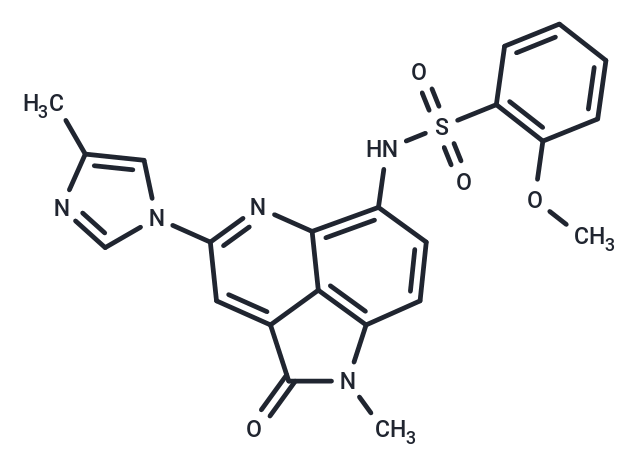Shopping Cart
- Remove All
 Your shopping cart is currently empty
Your shopping cart is currently empty

LT052 is a selective and efficient BET BD1 inhibitor with anti-inflammatory activity. It mediates the BRD4/NF-κB/NLRP3 inflammatory signaling pathway and can be used in gout arthritis research.

| Pack Size | Price | Availability | Quantity |
|---|---|---|---|
| 1 mg | $287 | In Stock | |
| 5 mg | $690 | In Stock | |
| 10 mg | $983 | In Stock | |
| 25 mg | $1,490 | In Stock | |
| 50 mg | $2,480 | In Stock |
| Description | LT052 is a selective and efficient BET BD1 inhibitor with anti-inflammatory activity. It mediates the BRD4/NF-κB/NLRP3 inflammatory signaling pathway and can be used in gout arthritis research. |
| Targets&IC50 | BRD3 BD1:246.3 nM, BRDT BD1:357.1 nM, BRD4 BD1:87.7 nM, BRPF1b:567.5 nM |
| In vitro | LT052 (1 μm,1h) inhibited MSU-induced apoptosis of THP-1 cells through the BRD4/NF-κB/NLRP3 signaling pathway. LT052 showed good inhibitory activity on NO production in RAW264.7 cells. LT052 inhibits NF-κB transcriptional activity in HUVECs. LT052 inhibits scorch death of macrophages in rat synovial tissue by regulating the BRD4/NF-κB/NLRP3 signaling pathway. [1] |
| In vivo | LT052 has a high clearance rate in the range of 93.517 µL/min/mg proteins to 146.685 µL/min/mg proteins in liver microsomes of multiple species (human, monkey, dog, rat). Overall, LT052 exhibits moderately stable levels of in vitro liver microsomal metabolism[1]. LT052 (1 mg/kg; intra-articular) suppresses synovial hyperplasia as well as severe neutrophil infiltration, and has a good therapeutic effect on MSU-induced acute gouty arthritis[1]. |
| Alias | LT 052 |
| Molecular Weight | 449.48 |
| Formula | C22H19N5O4S |
| Cas No. | 2543545-44-2 |
| Smiles | O=C1C2=CC(=NC3=C(C=CC(=C32)N1C)NS(=O)(=O)C=4C=CC=CC4OC)N5C=NC(=C5)C |
| Relative Density. | 1.49 g/cm3 (Predicted) |
| Storage | store at low temperature | Powder: -20°C for 3 years | In solvent: -80°C for 1 year | Shipping with blue ice. | ||||||||||||||||||||
| Solubility Information | DMSO: 5 mg/mL (11.12 mM), Sonication is recommended. | ||||||||||||||||||||
Solution Preparation Table | |||||||||||||||||||||
DMSO
| |||||||||||||||||||||

Copyright © 2015-2024 TargetMol Chemicals Inc. All Rights Reserved.